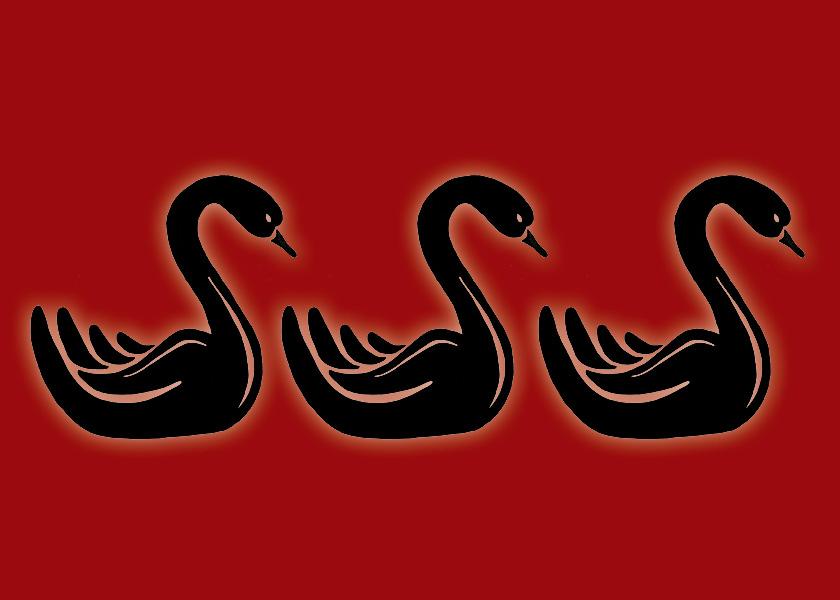Exponential Risk: The Only Two Black Swans That Matter

There seems to be another wave of anxiety creeping into agriculture’s consciousness, despite commodity prices at their highest point in more than a decade. Don’t you miss the good ol’ days when agriculture’s biggest worries were the weather and Trump’s tariffs on China? That seems a lifetime ago. Since then, we’ve endured a global pandemic, crippling supply chain issues, skyrocketing fertilizer and fuel prices, labor shortages, and the hits just keep on coming.
Forget about all the other black swans.
Only two really matter right now. Both involve war. One is a real war likely to have negative humanitarian and geo-political ramifications for generations—Russia’s war with Ukraine. History is yet to be written as to where all this leads. No one knows. What is clear is its negative effect on world food production.
The other is an economic war. This is the war on inflation that the Federal Reserve up until now had reluctantly refused to fight. In February, the cost of food in the U.S. increased by 7.9% year-over-year—the highest food inflation since July 1981. We were told such inflationary pressure would only be “transitory.” Any hope inflation would be temporary was shot down for good when Russia invaded Ukraine on Feb. 24.
Look at the numbers to understand the situation’s ulcerative nature.
Based on 2019 United Nations statistics, around one-quarter of global wheat exports come from Ukraine and Russia. One-fifth of global corn and barley, too. The two countries are the source of nearly two-thirds of traded sunflower oil; Ukraine accounts for almost half of global exports. This “status quo” of supply is undoubtedly at risk. The extreme volatility in grain markets has price levels not seen since the “commodity rush” during the global financial meltdown of 2008.
Such volatility is not likely to go away soon.
In March, Reuters reported Ukraine’s ag minister, Roman Leshchenko, said farmers may only plant about 7 million hectares this year compared to 15 million last year. Winter wheat, which is already in the ground, is looking at a reduction, too. Leshchenko stated farmers planted 6.5 million hectares of winter wheat, but the harvested area may only be around 4 million. Each day the war goes on, those numbers will be overoptimistic at best.
However, the biggest black swan for U.S. agriculture is fertilizer prices.
Because 90% of all fertilizer is used outside the U.S, the actions of Russia will impact the global fertilizer market for months, if not years, to come. Russia is the second largest producer of ammonia, urea and potash, and it’s the fifth largest producer of processed phosphates. In terms of its contribution to global exports, Russia accounts for 23% of ammonia, 14% of urea, 21% of potash and 10% of processed phosphate.
In turn, the conflict in Ukraine puts additional stress and uncertainty on energy markets. Russia supplies approximately one-third of Europe’s natural gas—the main feedstock to produce nitrogen fertilizers. In June 2020, the average price of anhydrous ammonia fertilizer was $226 per ton. In February 2021, it was $432. One year later, even before the Russian invasion, it hit an all-time high of $1,492. Now, all bets are off.
Meanwhile, the increase in farmland prices has blown the roof off the barn. The 2021 Iowa State University land values survey reported that average Iowa farmland values increased by 29% to $9,751 per acre from 2020 to 2021.
The Federal Reserve intends to smother such inflation with an anticipated seven interest rate hikes this year.
The first one came on March 16 with a 0.25-point increase in the basis.
With the situation in Ukraine only adding jet fuel to the fire, many are asking whether the Fed showed up too late and with too little resources to fight the inferno.
For those in production agriculture, this fire is burning pretty hot. Input, machinery and land costs are accelerating at rates even faster than the overall average rate of inflation. Loan amounts are likely to balloon to new high levels. Add 200 basis points or more to borrowing costs for inputs, machinery and land, and overall risk has risen exponentially.
This is the immediate challenge for U.S. agriculture—to manage increased risk and deliver stability to global food production that the world so desperately needs right now.







